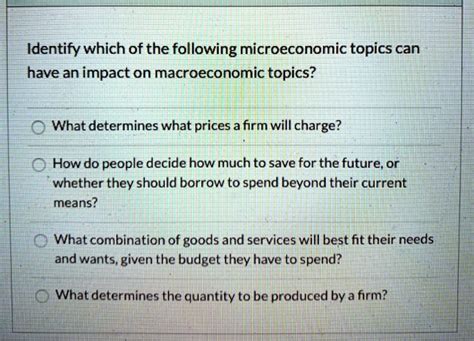Microeconomics is the study of the behavior of individual entities, such as households, firms, and individuals, in decision-making and the allocation of resources. It examines how these entities interact in markets and how prices and quantities are determined. Some examples of microeconomic topics include:

-
Consumer behavior: How consumers make decisions about what to buy, how much to buy, and when to buy it.
-
Firm behavior: How firms make decisions about what to produce, how much to produce, and how to price their products.
-
Market structure: The structure of markets, such as perfect competition, monopoly, and oligopoly, and how this structure affects the behavior of firms and consumers.
-
Government intervention: The role of government in the economy, such as through taxes, subsidies, and regulations.
On the other hand, macroeconomic topics focus on the economy as a whole, such as:
- Economic growth: The rate at which the economy is growing.
- Inflation: The rate at which prices are rising.
- Unemployment: The percentage of the labor force that is unemployed.
- Fiscal policy: The use of government spending and taxation to influence the economy.
- Monetary policy: The use of interest rates and the money supply by central banks to influence the economy.
Here is a table summarizing the difference between microeconomics and macroeconomics:
| Characteristic | Microeconomics | Macroeconomics |
|---|---|---|
| Focus | Individual entities | Economy as a whole |
| Topics | Consumer behavior, firm behavior, market structure, government intervention | Economic growth, inflation, unemployment, fiscal policy, monetary policy |
There are a few key things to look for when trying to identify microeconomic topics:
- Does the topic focus on individual entities? If the topic is about the behavior of individual households, firms, or individuals, then it is likely a microeconomic topic.
- Does the topic involve decision-making? Microeconomics is all about how entities make decisions about what to buy, how much to buy, and when to buy it. If the topic involves decision-making, then it is likely a microeconomic topic.
- Does the topic involve the allocation of resources? Microeconomics is also about how entities allocate their resources. If the topic involves the allocation of resources, then it is likely a microeconomic topic.
Here are some examples of microeconomic topics:
- The impact of price changes on consumer demand
- The effect of government subsidies on firm production decisions
- The role of market power in determining prices
- The impact of technological change on industry structure
- The effect of minimum wage laws on employment
Microeconomics is important because it helps us to understand how the economy works at the individual level. This understanding is essential for making informed decisions about economic policy. For example, microeconomics can help us to understand the impact of taxes on consumer behavior, the effect of government regulations on firm production decisions, and the role of market power in determining prices.
Microeconomics is a branch of economics that focuses on the behavior of individual entities, such as households, firms, and individuals. It examines how these entities interact in markets and how prices and quantities are determined. Microeconomic topics are important because they help us to understand how the economy works at the individual level.
